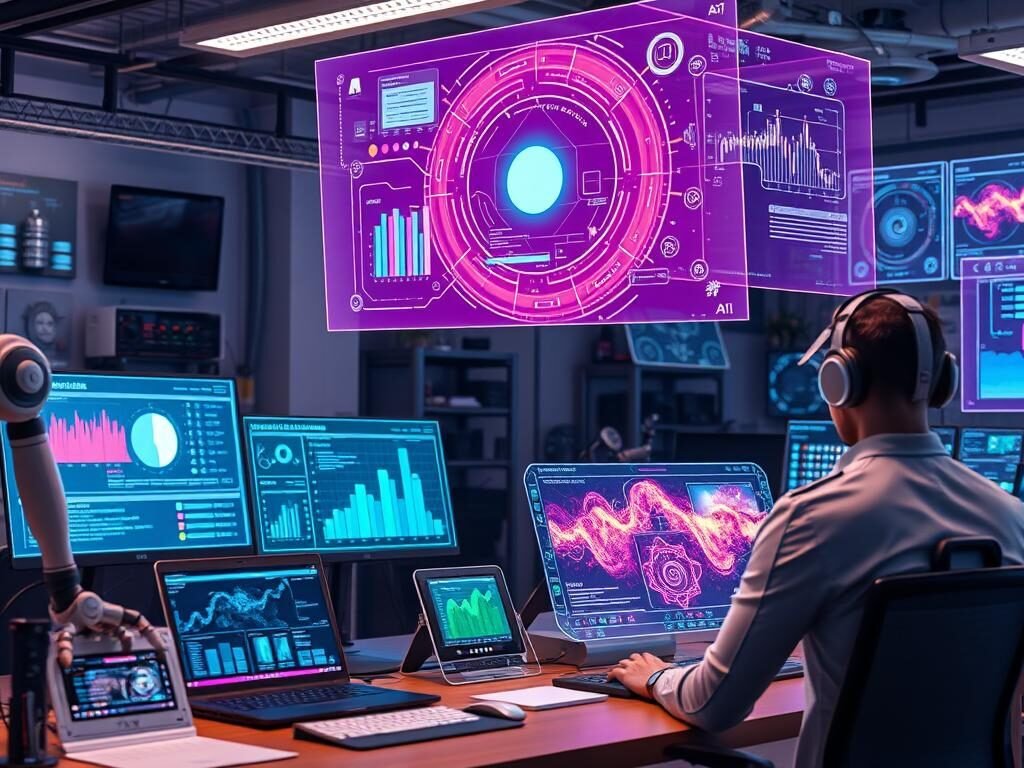In today’s world, artificial intelligence (AI) is everywhere. A big change is happening that will change how we innovate and do business. Generative AI and Applied AI are coming together to bring new levels of creativity and efficiency. They are changing how we solve problems, come up with ideas, and create digital solutions.
A recent study by McKinsey & Company found that 72% of businesses use AI in their work. This shows how big of an impact AI is having on industries worldwide. It’s changing how we work, create, and serve our customers.

In this article, we’ll look at Generative AI and Applied AI. We’ll explore their basics, how they’ve evolved, and what makes them different. We’ll also see how they’re changing business, from understanding language to seeing the world in new ways. And we’ll share tips on how to use them together to boost efficiency.
Key Takeaways
- Generative AI and Applied AI are coming together to change how we create and work in the digital world.
- Businesses are quickly adopting AI, with 72% already using it in their work.
- It’s important to understand Generative AI and Applied AI to use their full potential.
- AI is making big strides in understanding language and seeing the world, opening up new possibilities.
- Using Generative AI and Applied AI together can lead to big gains in efficiency and innovation.
Understanding the Foundations of Generative AI and Applied AI
In the world of artificial intelligence, Generative AI and Applied AI are built on neural networks and deep learning. These technologies have changed how we solve complex problems. They open up new ways to innovate in many fields.
Key Components of Neural Networks and Deep Learning
At the core of Generative and Applied AI are neural networks, modeled after the human brain. These networks have layers of artificial neurons that process data. This lets systems learn and grow. Deep learning uses these networks to solve hard tasks with great skill and speed.
The Evolution of Machine Learning Architecture
The field of machine learning has grown a lot, thanks to new architectures and computing power. From simple algorithms to today’s advanced models, AI has made huge strides. These advances have pushed the limits of what AI can do.
Fundamental Differences Between Generative and Applied AI
Generative AI and Applied AI both use neural networks and machine learning. But they have different main goals and ways of working. Generative AI creates new content like images and text. On the other hand, Applied AI uses AI to solve specific problems, like in computer vision and decision-making.
| Characteristic | Generative AI | Applied AI |
|---|---|---|
| Primary Goal | Content Creation | Problem-Solving |
| Methodology | Learning Patterns and Distributions | Developing Task-Specific Algorithms |
| Applications | Artistic Expression, Storytelling, Synthetic Data Generation | Predictive Analytics, Automated Decision-Making, Computer Vision |
Knowing the basics and differences between Generative and Applied AI helps us use these powerful technologies. They can lead to new opportunities in our digital world.
Transformative Applications in Modern Business Solutions
In today’s digital world, business solutions powered by AI applications are changing how companies work and grow. Generative and Applied AI are being used in many fields. They are making business processes better, helping with decision-making, and pushing digital transformation forward.
The financial sector is a great example. AI algorithms are now handling credit risk, fraud, and portfolio management. This use of machine learning and natural language processing helps banks and fintech companies make smarter choices. They can cut costs and offer better services to their customers.
In healthcare, AI is making big strides too. It’s helping with medical imaging, finding new drugs, and creating personalized treatments. Generative AI can create new drug ideas, while Applied AI can spot diseases and suggest treatments. This leads to better patient care and smoother clinical work.
The manufacturing world is also seeing AI’s impact. Business solutions with AI for predictive maintenance, supply chain management, and quality control are boosting productivity. They help reduce downtime and make operations more efficient.
“AI is not just transforming individual business processes; it’s reshaping entire industries, unlocking new avenues for innovation and growth.”
As more companies use AI applications, they’re getting ahead, improving customer service, and driving digital transformation.
The use of Generative and Applied AI in business solutions shows their huge potential. It’s opening doors for a future where human creativity and AI work together. This will bring about new chances for growth and success.
Natural Language Processing and Computer Vision Breakthroughs
Advances in natural language processing and computer vision are changing how we use digital systems. These technologies, from text generation to image synthesis, are pushing the limits of creativity and efficiency.
Advanced Text Generation and Language Models
New language models, thanks to natural language processing, are creating text that feels almost human. They can write summaries and even creative stories with ease. This has made content creation faster and more personalized.
Visual Recognition and Image Synthesis Technologies
Computer vision has made it possible to understand and manipulate images like never before. Algorithms can now spot objects, scenes, and even emotions with incredible accuracy. Image synthesis can create stunning images from scratch or change existing ones, opening up new creative possibilities.
Multi-modal AI Systems Integration
The merging of natural language processing and computer vision has led to multi-modal AI systems. These systems can handle text, images, and speech, making interactions with machines more natural. This integration is opening up new areas like virtual assistants and immersive experiences.
“The fusion of natural language processing and computer vision is ushering in a new era of multi-modal AI that redefines how we engage with technology.”

Maximizing Efficiency Through AI Integration Strategies
As the world moves towards Generative AI and Applied AI, businesses are finding new ways to use these technologies. They are looking at how to blend AI with efficiency and transformer models. This blend can make businesses more productive and competitive.
Choosing the right AI models is key to successful integration. Transformer models are changing the game in tasks like natural language processing and computer vision. They can automate many business tasks, giving employees more time for important work.
Implementing AI also needs a good plan for change management. This includes training employees to use AI tools well. A culture that values AI innovation can make a business more productive and creative.
| AI Integration Strategies | Key Benefits |
|---|---|
| Deployment of Transformer Models | Improved accuracy, speed, and scalability in natural language processing and computer vision tasks |
| Intelligent Automation of Business Processes | Streamlined workflows, reduced manual effort, and enhanced decision-making capabilities |
| Comprehensive Employee Training and Upskilling | Increased user adoption, greater utilization of AI-powered tools, and a culture of AI-driven innovation |
By using these AI integration strategies, businesses can become more efficient. They will be ready for the future of AI. Companies that invest in transformer models and a complete AI plan will do well.

Conclusion
Generative AI and Applied AI are changing the digital world. They use neural networks and deep learning to bring new ideas and efficiency to many fields. This has opened up new ways to be creative and solve problems.
The future of AI trends looks bright. We’re seeing big steps forward in how AI understands and interacts with us. This will help drive digital innovation in our lives.
By combining Generative and Applied AI, companies can grow and improve. They can make their products better and work more efficiently. This will help them stay ahead in a fast-changing world.
FAQ
What is the difference between Generative AI and Applied AI?
Generative AI creates new content like text, images, or audio. Applied AI is for tasks like data analysis and problem-solving. Generative AI uses deep learning, while Applied AI uses neural networks to improve efficiency.
How are Generative AI and Applied AI transforming business solutions?
Generative and Applied AI are changing industries by boosting creativity and streamlining processes. They help automate tasks, create personalized content, and make better decisions. This leads to innovation and insights from data.
What are the key advancements in Natural Language Processing (NLP) and Computer Vision?
NLP has led to advanced language models like GPT-3, which write like humans. Computer Vision has improved image recognition and synthesis, making images more realistic.
How can businesses effectively integrate Generative and Applied AI into their operations?
To integrate AI well, businesses need a strategic plan. This plan should match business goals, tackle challenges, and boost efficiency. It involves starting with pilot projects and ensuring data security.
What are the future trends in the convergence of Generative and Applied AI?
Future AI advancements will lead to more complex systems that combine text, vision, and speech. These technologies will be key in digital creativity, productivity, and decision-making in many industries.


























